Front Brake Caliper Replacement Pin Slider
Caution: Refer to Brake Dust Caution in the Preface section.
Caution: Refer to Brake Fluid Irritant Caution in the Preface section.
Removal Procedure
- Apply the parking brake.
- Block the wheels.
- Remove about 2/3 of the brake fluid from the master cylinder reservoir.
- Raise the vehicle. Support the vehicle with safety stands. Refer to Lifting and Jacking the Vehicle .
- Remove the tires and wheels. Refer to Tire and Wheel Removal and Installation .
- Remove the brake caliper mounting bolts.
- Compress the pistons, using a C-clamp between the inner brake caliper housing and the outer brake pad.
- Compress the pistons, using screwdrivers to pry between the outer brake caliper housing and the outer brake pad.
- While compressing the pistons, watch the reservoir for possible brake fluid overflow.
- Disconnect the brake hose.
- Cap or tape the brake hose fitting in order to prevent contamination.
- Remove the brake caliper.
Important:
• Do not completely drain the master cylinder reservoir. • Drain the fluid from the brake caliper bleeder valve. • Drained the fluid into a suitable container. Discard the fluid.
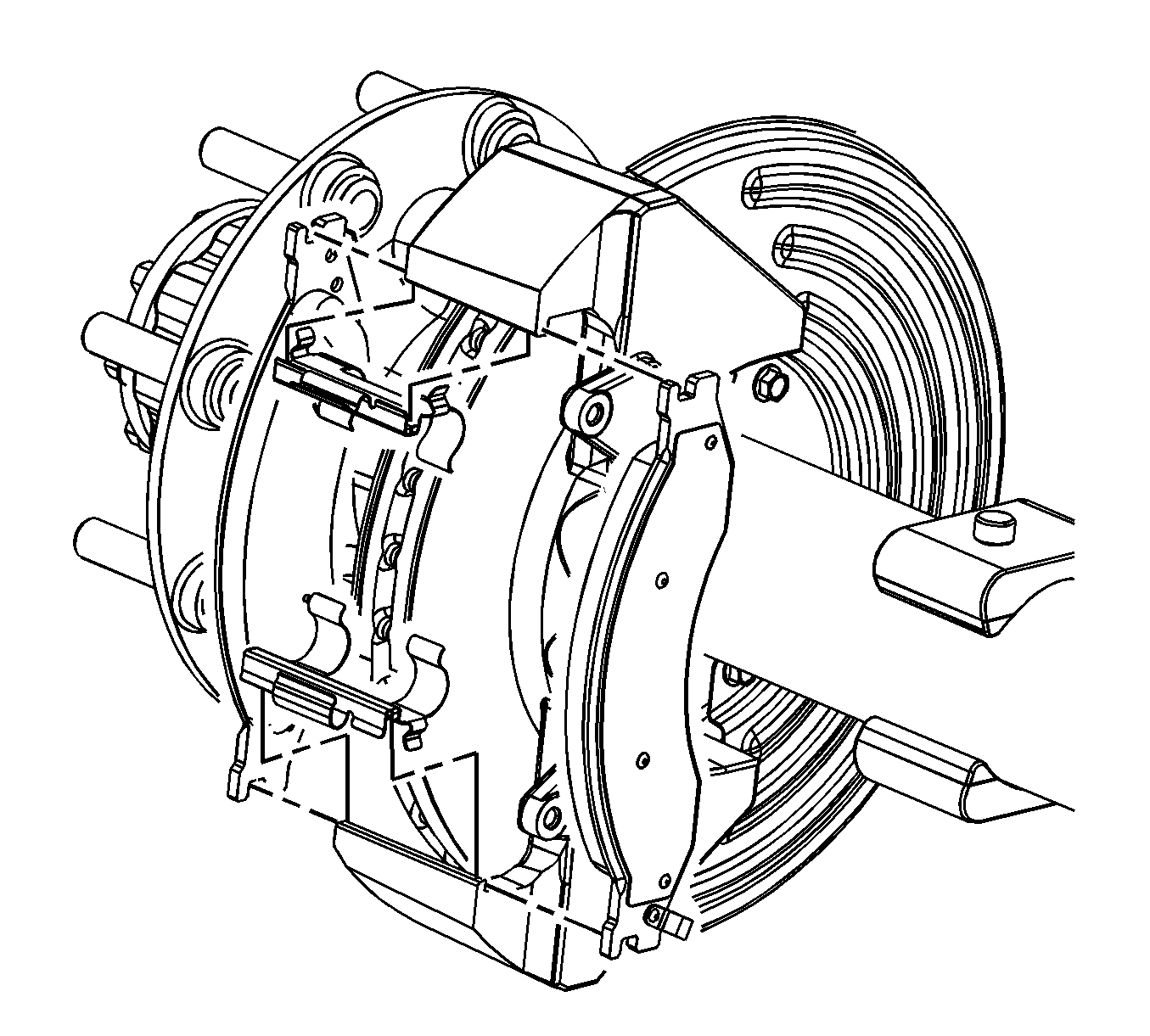
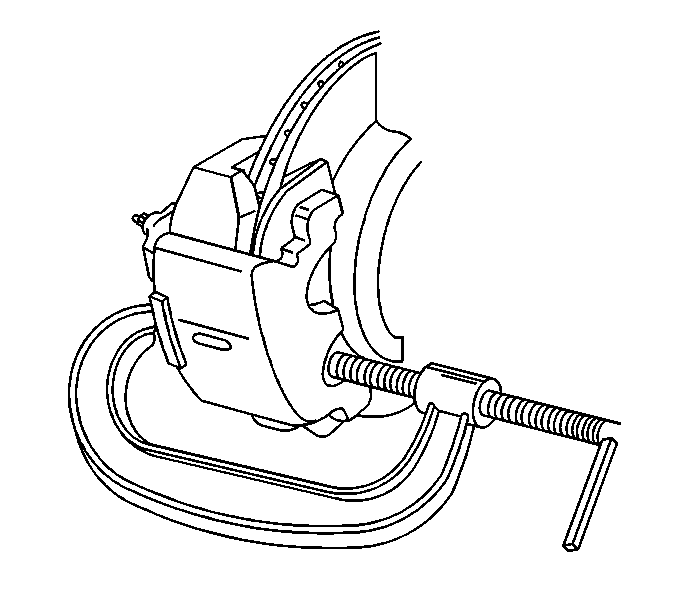
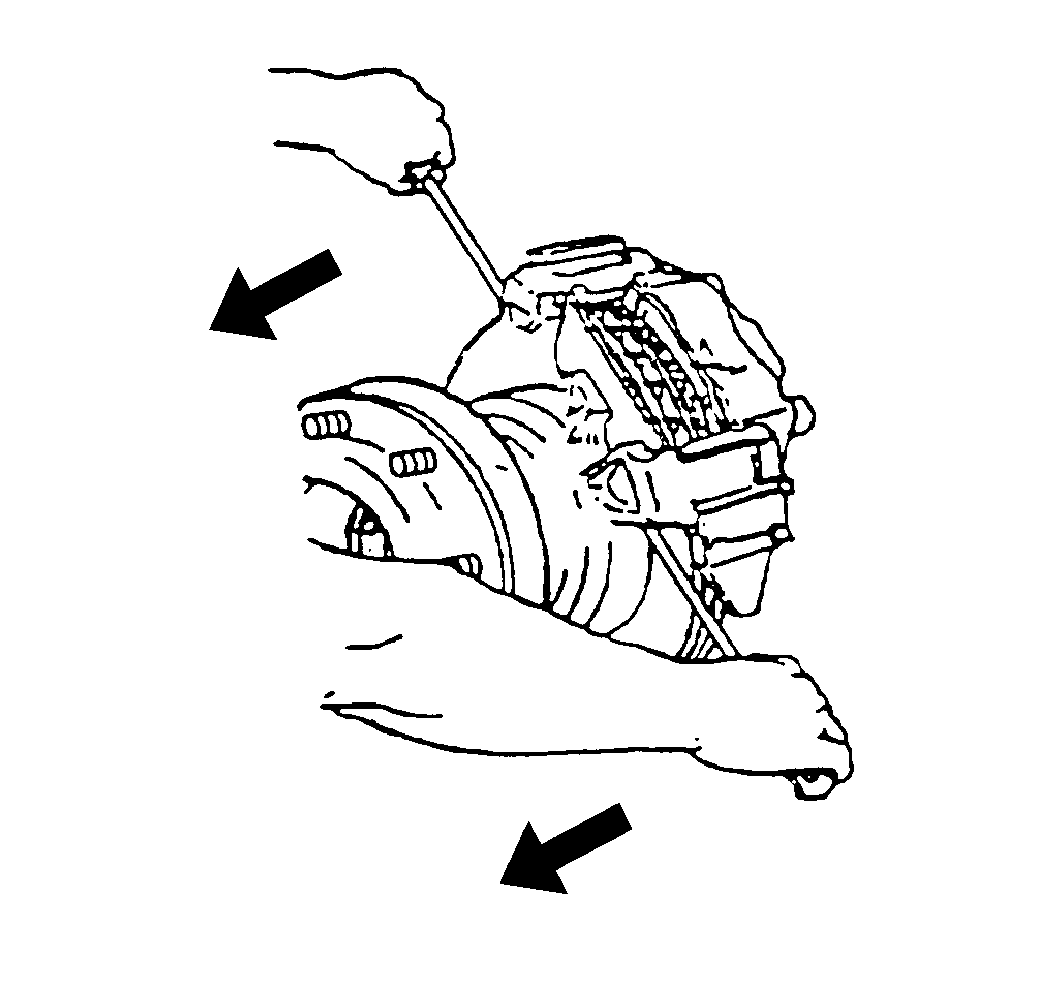
Notice: Do not allow calipers to hang from the flexible hoses. Doing so can damage the hoses.
Inspection Procedure
Caution: Refer to Brake Dust Caution in the Preface section.
Clean the area around the brake hose on the brake caliper using denatured alcohol or an equivalent approved brake cleaner.
Installation Procedure
- Apply a thin coat of brake caliper lubricant GM P/N 89021536 (Canadian P/N 89021538) or equivalent, to the brake caliper support pin surfaces.
- Fully compress pistons in the caliper.
- Install the brake caliper.
- Install the brake hose.
- Loosely assemble the brake hose nut to the brake caliper.
- Loosely assemble the brake hose bracket to the brake caliper.
- Fill the master cylinder reservoir with brake fluid. Use Brake Fluid GM P/N 1052535 or equivalent. Refer to Master Cylinder Reservoir Filling .
- Bleed the hydraulic brake system. Refer to Hydraulic Brake System Bleeding .
- Pump the brake pedal several times in order to ensure that the pedal is firm and the brake linings are adjusted.
- Install the tires and wheels. Refer to Tire and Wheel Removal and Installation .
- Lower the vehicle. Refer to Lifting and Jacking the Vehicle .
- Remove the wheel blocks.
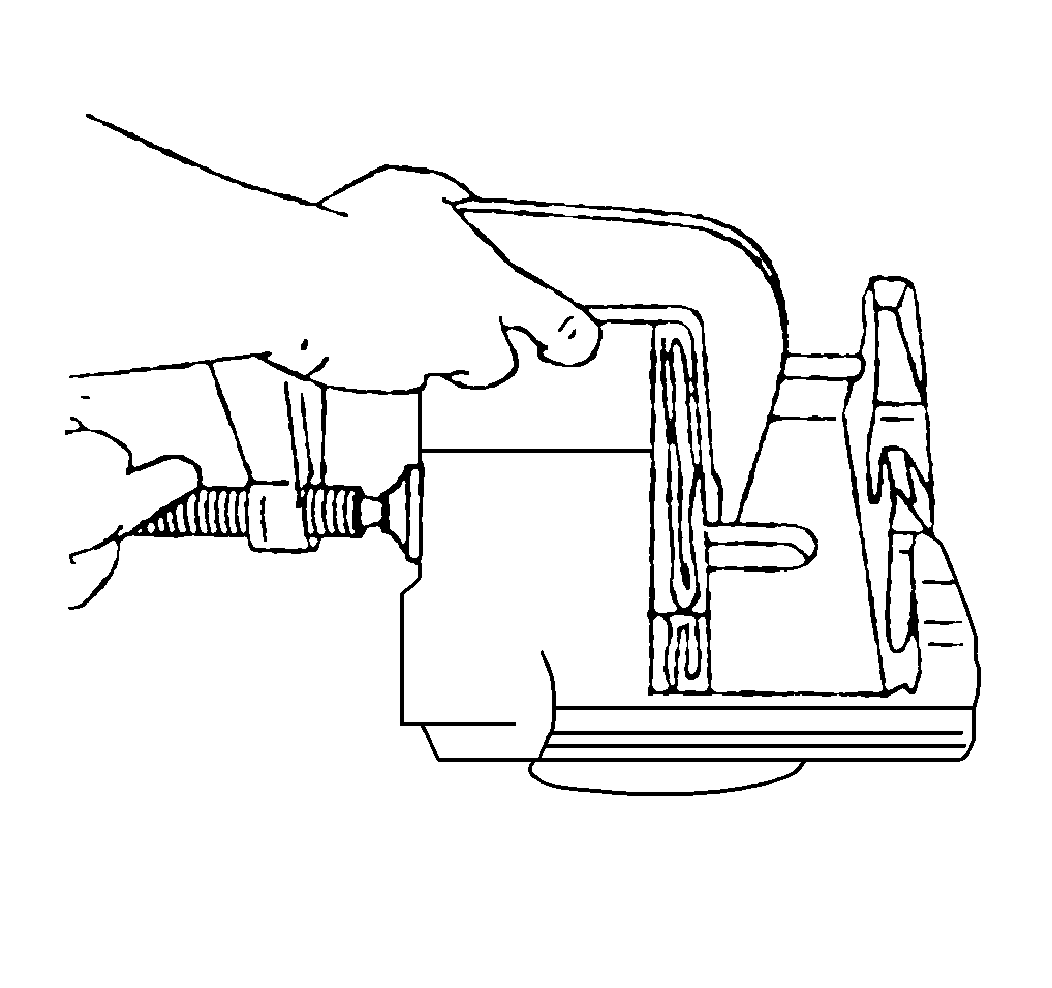
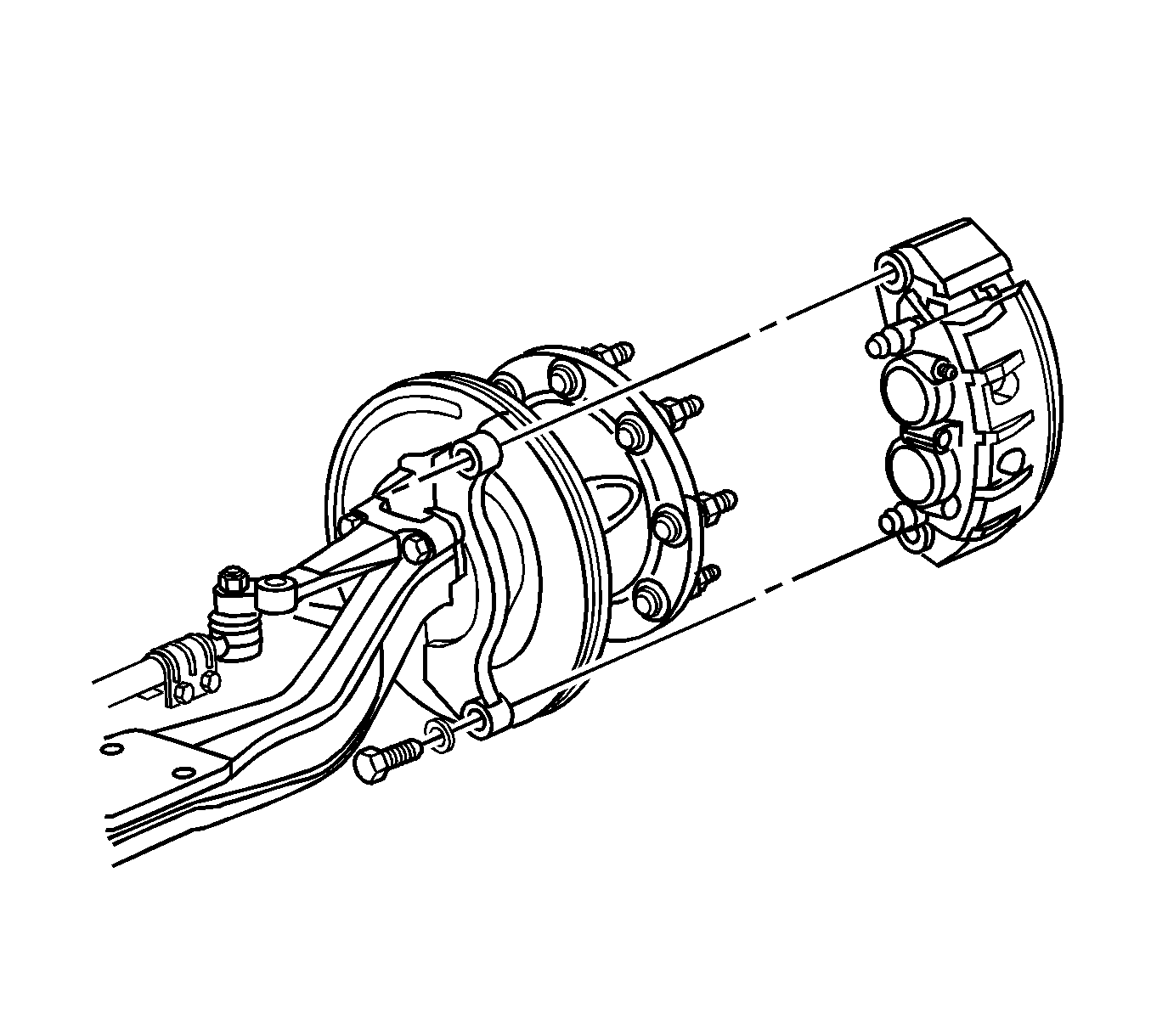
Notice: Refer to Installing Hoses without Twists or Bends Notice in the Preface section.
Notice: Refer to Fastener Notice in the Preface section.
Tighten
| • | Tighten the brake hose nut to 40 N·m (30 lb ft). |
| • | Tighten the caliper mounting nuts to 63 N·m (46 lb ft). |
Important: Check the fluid level in the master cylinder reservoir after pumping the brake pedal.
Caution: Do not move the vehicle until a firm brake pedal is obtained. Failure to obtain a firm pedal before moving vehicle may result in personal injury.
Front Brake Caliper Replacement Dayton-Walther 6500,7500,8500,FM6/FS7
Removal Procedure
- Apply the parking brake.
- Block the wheels.
- Remove about 2/3 of the brake fluid from the master cylinder reservoir.
- Raise the vehicle. Support the vehicle with safety stands. Refer to Lifting and Jacking the Vehicle .
- Remove the tires and wheels. Refer to Tire and Wheel Removal and Installation .
- Remove the brake caliper retainer bolt.
- Remove the brake caliper retainer and brake caliper spring using a brass punch.
- Compress the pistons using a C-clamp between the inner brake caliper housing and the outer brake pad.
- Compress the pistons using screwdrivers to pry between the outer brake caliper housing and the outer brake pad.
- While compressing the pistons, watch the reservoir for possible brake fluid overflow.
- Disconnect the brake hose.
- Cap or tape the brake hose fitting in order to prevent contamination.
- Remove the brake caliper.
Important:
• Do not completely drain the master cylinder reservoir. • Drain the fluid from the brake caliper bleeder valve. • Drain the fluid into a suitable container. Discard the fluid.



Notice: Do not allow calipers to hang from the flexible hoses. Doing so can damage the hoses.
Inspection Procedure
- Clean the area around the brake hose on the brake caliper. Use Brake Parts cleaner GM P/N 12345754 or the equivalent.
- Inspect the support rail surfaces on the brake caliper.
- Inspect the support rail surfaces on the brake caliper mounting plate.
- Inspect the heat shields. If the heat shields are loose, replace the shields.
Caution: Refer to Brake Dust Caution in the Preface section.
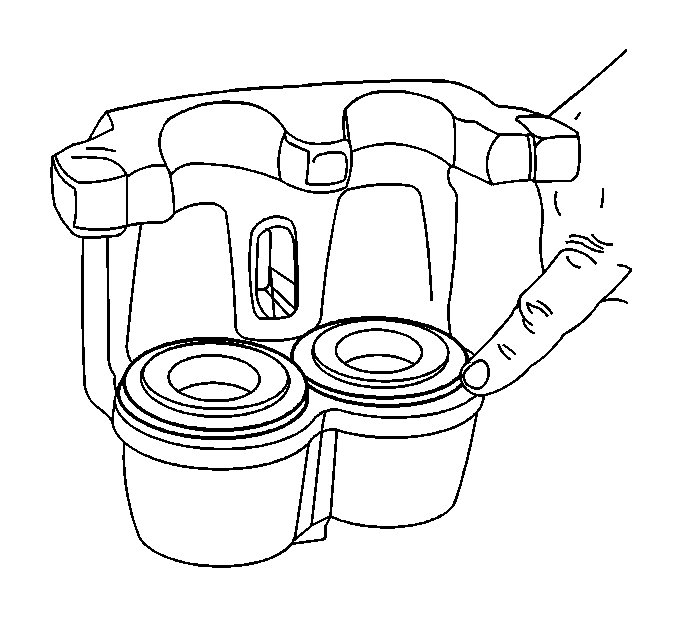
Installation Procedure
- Clean the support rail surfaces of the brake caliper with a wire brush. File smooth any deep nicks or gouges.
- Clean the support rail surfaces of the brake caliper mounting plate with a wire brush. File smooth any deep nicks or gouges.
- Apply a thin coat of Brake Caliper Lubricant GM P/N 12377969, or equivalent, to the brake caliper support rail surfaces.
- Apply a thin coat of Brake Caliper Lubricant GM P/N 12377969, or equivalent, to the brake caliper mounting plate support rail surfaces.
- Fully compress pistons into the caliper.
- Install the brake caliper.
- Install the brake hose.
- Loosely assemble the brake hose nut to the brake caliper.
- Loosely assemble the brake hose bracket to the brake caliper.
- Install a NEW brake caliper retainer bolt.
- Fill the master cylinder reservoir with brake fluid. Use Brake Fluid GM P/N 1052535, or equivalent. Refer to Master Cylinder Reservoir Filling .
- Bleed the hydraulic brake system. Refer to Hydraulic Brake System Bleeding .
- Pump the brake pedal several times in order to ensure that the pedal is firm and the brake linings are adjusted.
- Install the tires and wheels. Refer to Tire and Wheel Removal and Installation .
- Lower the vehicle. Refer to Lifting and Jacking the Vehicle .
- Remove the wheel blocks.



Notice: Refer to Installing Hoses without Twists or Bends Notice in the Preface section.
Notice: Refer to Fastener Notice in the Preface section.
Tighten
| • | Tighten the brake hose nut to 19 N·m (14 lb ft). |
| • | Tighten the brake hose bracket bolts to 32 N·m (24 lb ft). |
Important:
• The brake caliper retainer bolt boss must fit in the circular hole in the brake caliper retainer. • Do not reuse the brake caliper retainer bolt .
Tighten
Tighten the brake caliper retainer bolt to 450 N·m (332 lb ft).
Important: Check the fluid level in the master cylinder reservoir after pumping the brake pedal.
Front Brake Caliper Replacement 4500, 5500, FRX
Removal Procedure
- Apply the parking brake.
- Block the wheels.
- Remove about 2/3 of the brake fluid from the master cylinder reservoir.
- Raise the vehicle. Support the vehicle with safety stands. Refer to Lifting and Jacking the Vehicle .
- Remove the tires and wheels. Refer to Tire and Wheel Removal and Installation .
- Remove the brake caliper retainer bolt.
- Remove the brake caliper retainer and brake caliper spring using a brass punch.
- Compress the pistons, using a C-clamp between the inner brake caliper housing and the outer brake pad.
- Compress the pistons, using screwdrivers to pry between the outer brake caliper housing and the outer brake pad.
- While compressing the pistons, watch the reservoir for possible brake fluid overflow.
- Remove the wheel speed sensor.
- Disconnect the brake hose.
- Cap or tape the brake hose fitting in order to prevent contamination.
- Remove the brake caliper.
Important:
• Do not completely drain the master cylinder reservoir. • Drain the fluid from the brake caliper bleeder valve. • Drain the fluid into a suitable container. Discard the fluid.
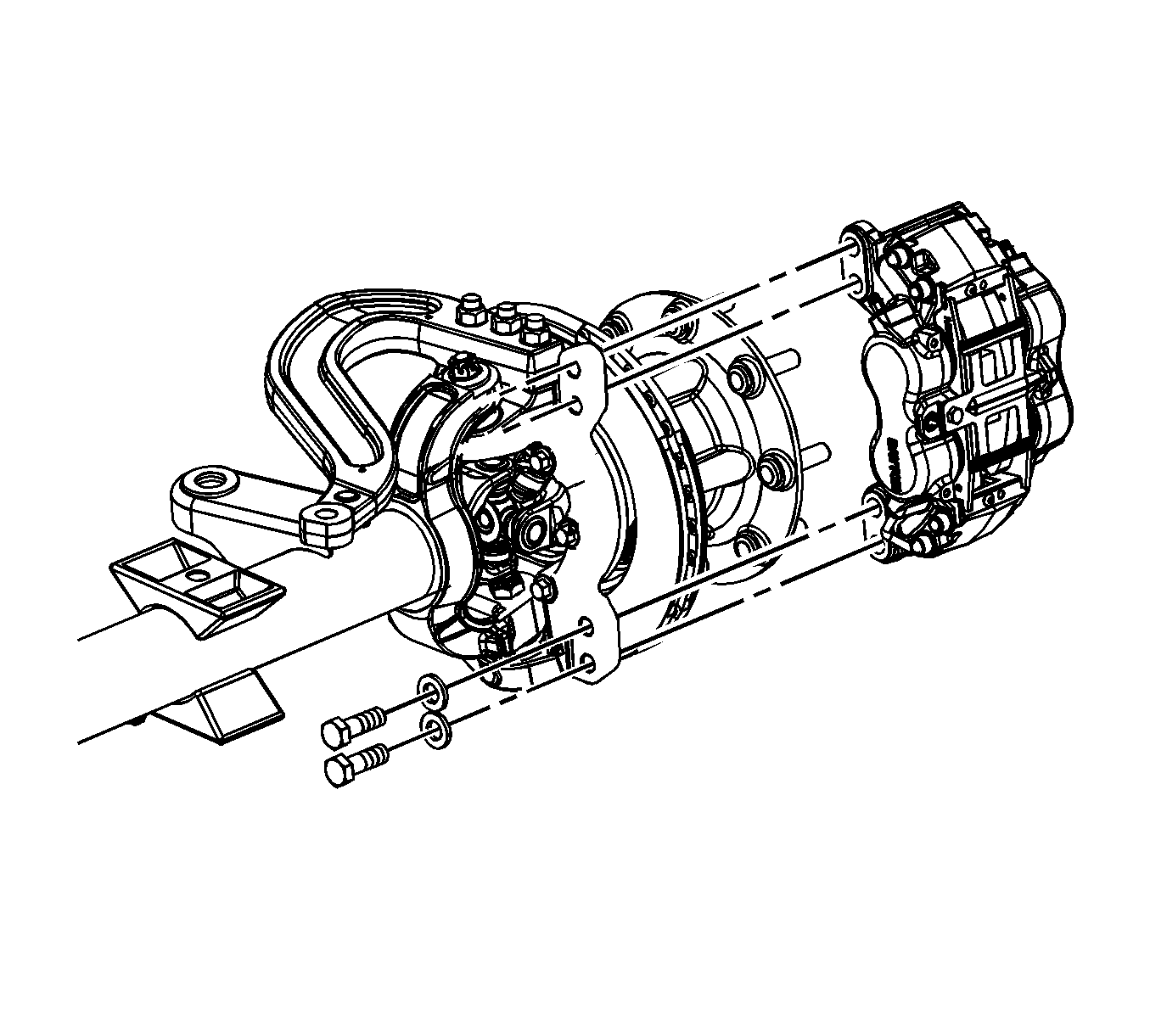


Notice: Do not allow calipers to hang from the flexible hoses. Doing so can damage the hoses.
Inspection Procedure
- Clean the area around the brake hose on the brake caliper. Use Brake Parts cleaner GM P/N 12345754 or the equivalent.
- Inspect the support rail surfaces on the brake caliper.
- Inspect the support rail surfaces on the brake caliper mounting plate.
- Inspect the heat shields. If the heat shields are loose, replace the shields.
Caution: Avoid taking the following actions when you service wheel brake parts:
• Do not grind brake linings. • Do not sand brake linings. • Do not clean wheel brake parts with a dry brush or with compressed air.

Installation Procedure
- Clean the support rail surfaces of the brake caliper with a wire brush. File smooth any deep nicks or gouges.
- Clean the support rail surfaces of the brake caliper mounting plate with a wire brush. File smooth any deep nicks or gouges.
- Apply a thin coat of Brake Caliper Lubricant GM P/N 12377969, or equivalent, to the brake caliper support rail surfaces.
- Apply a thin coat of Brake Caliper Lubricant GM P/N 12377969, or equivalent, to the brake caliper mounting plate support rail surfaces.
- Fully compress pistons into the caliper.
- Install the brake caliper.
- Install the brake hose.
- Loosely assemble the brake hose nut to the brake caliper.
- Loosely assemble the brake hose bracket to the brake caliper.
- Install a NEW brake caliper retainer bolt.
- Fill the master cylinder reservoir with brake fluid. Use Brake Fluid GM P/N 1052535, or equivalent. Refer to Master Cylinder Reservoir Filling .
- Bleed the hydraulic brake system. Refer to Hydraulic Brake System Bleeding .
- Pump the brake pedal several times in order to ensure that the pedal is firm and the brake linings are adjusted.
- Install the tires and wheels. Refer to Tire and Wheel Removal and Installation .
- Lower the vehicle. Refer to Lifting and Jacking the Vehicle .
- Remove the wheel blocks.



Notice: Refer to Installing Hoses without Twists or Bends Notice in the Preface section.
Notice: Use the correct fastener in the correct location. Replacement fasteners must be the correct part number for that application. Fasteners requiring replacement or fasteners requiring the use of thread locking compound or sealant are identified in the service procedure. Do not use paints, lubricants, or corrosion inhibitors on fasteners or fastener joint surfaces unless specified. These coatings affect fastener torque and joint clamping force and may damage the fastener. Use the correct tightening sequence and specifications when installing fasteners in order to avoid damage to parts and systems.
Tighten
| • | Tighten the brake hose nut to 19 N·m (14 lb ft). |
| • | Tighten the brake hose bracket bolts to 32 N·m (24 lb ft). |
Important:
• The brake caliper retainer bolt boss must fit in the circular hole in the brake caliper retainer. • Do not reuse the brake caliper retainer bolt .
Tighten
Tighten the brake caliper retainer bolt to 450 N·m (332 lb ft).
Important: Check the fluid level in the master cylinder reservoir after pumping the brake pedal.
Front Brake Caliper Replacement 4500, 5500, FM7/FM8
Removal Procedure
- Apply the parking brake.
- Block the wheels.
- Remove about 2/3 of the brake fluid from the master cylinder reservoir.
- Raise the vehicle. Support the vehicle with safety stands. Refer to Lifting and Jacking the Vehicle .
- Remove the tires and wheels. Refer to Tire and Wheel Removal and Installation .
- Remove the brake caliper retainer bolt.
- Remove the brake caliper retainer and brake caliper spring using a brass punch.
- Compress the pistons using a C-clamp between the inner brake caliper housing and the outer brake pad.
- Compress the pistons using screwdrivers to pry between the outer brake caliper housing and the outer brake pad.
- While compressing the pistons, watch the reservoir for possible brake fluid overflow.
- Disconnect the brake hose.
- Cap or tape the brake hose fitting in order to prevent contamination.
- Remove the brake caliper.
Important:
• Do not completely drain the master cylinder reservoir. • Drain the fluid from the brake caliper bleeder valve. • Drain the fluid into a suitable container. Discard the fluid.



Notice: Do not allow calipers to hang from the flexible hoses. Doing so can damage the hoses.
Inspection Procedure
- Clean the area around the brake hose on the brake caliper. Use Brake Parts cleaner GM P/N 12345754 or the equivalent.
- Inspect the support rail surfaces on the brake caliper.
- Inspect the support rail surfaces on the brake caliper mounting plate.
- Inspect the heat shields. If the heat shields are loose, replace the shields.
Caution: Avoid taking the following actions when you service wheel brake parts:
• Do not grind brake linings. • Do not sand brake linings. • Do not clean wheel brake parts with a dry brush or with compressed air.

Installation Procedure
- Clean the support rail surfaces of the brake caliper with a wire brush. File smooth any deep nicks or gouges.
- Clean the support rail surfaces of the brake caliper mounting plate with a wire brush. File smooth any deep nicks or gouges.
- Apply a thin coat of Brake Caliper Lubricant GM P/N 12377969, or equivalent, to the brake caliper support rail surfaces.
- Apply a thin coat of Brake Caliper Lubricant GM P/N 12377969, or equivalent, to the brake caliper mounting plate support rail surfaces.
- Fully compress pistons into the caliper.
- Install the brake caliper.
- Install the brake hose.
- Loosely assemble the brake hose nut to the brake caliper.
- Loosely assemble the brake hose bracket to the brake caliper.
- Install a NEW brake caliper retainer bolt.
- Fill the master cylinder reservoir with brake fluid. Use Brake Fluid GM P/N 1052535, or equivalent. Refer to Master Cylinder Reservoir Filling .
- Bleed the hydraulic brake system. Refer to Hydraulic Brake System Bleeding .
- Pump the brake pedal several times in order to ensure that the pedal is firm and the brake linings are adjusted.
- Install the tires and wheels. Refer to Tire and Wheel Removal and Installation .
- Lower the vehicle. Refer to Lifting and Jacking the Vehicle .
- Remove the wheel blocks.



Notice: Refer to Installing Hoses without Twists or Bends Notice in the Preface section.
Notice: Use the correct fastener in the correct location. Replacement fasteners must be the correct part number for that application. Fasteners requiring replacement or fasteners requiring the use of thread locking compound or sealant are identified in the service procedure. Do not use paints, lubricants, or corrosion inhibitors on fasteners or fastener joint surfaces unless specified. These coatings affect fastener torque and joint clamping force and may damage the fastener. Use the correct tightening sequence and specifications when installing fasteners in order to avoid damage to parts and systems.
Tighten
| • | Tighten the brake hose nut to 19 N·m (14 lb ft). |
| • | Tighten the brake hose bracket bolts to 32 N·m (24 lb ft). |
Important:
• The brake caliper retainer bolt boss must fit in the circular hole in the brake caliper retainer. • Do not reuse the brake caliper retainer bolt .
Tighten
Tighten the brake caliper retainer bolt to 450 N·m (332 lb ft).
Important: Check the fluid level in the master cylinder reservoir after pumping the brake pedal.
Front Brake Caliper Replacement 6500, 7500, 8500, FM8
Removal Procedure
- Apply the parking brake.
- Block the wheels.
- Remove about 2/3 of the brake fluid from the master cylinder reservoir.
- Raise the vehicle. Support the vehicle with safety stands. Refer to Lifting and Jacking the Vehicle .
- Remove the tires and wheels. Refer to Tire and Wheel Removal and Installation .
- Remove the brake caliper retainer bolt.
- Remove the brake caliper retainer and brake caliper spring using a brass punch.
- Compress the pistons using a C-clamp between the inner brake caliper housing and the outer brake pad.
- Compress the pistons using screwdrivers to pry between the outer brake caliper housing and the outer brake pad.
- While compressing the pistons, watch the reservoir for possible brake fluid overflow.
- Disconnect the brake hose.
- Cap or tape the brake hose fitting in order to prevent contamination.
- Remove the brake caliper.
Important:
• Do not completely drain the master cylinder reservoir. • Drain the fluid from the brake caliper bleeder valve. • Drain the fluid into a suitable container. Discard the fluid.



Notice: Do not allow calipers to hang from the flexible hoses. Doing so can damage the hoses.
Inspection Procedure
- Clean the area around the brake hose on the brake caliper. Use Brake Parts cleaner GM P/N 12345754 or the equivalent.
- Inspect the support rail surfaces on the brake caliper.
- Inspect the support rail surfaces on the brake caliper mounting plate.
- Inspect the heat shields. If the heat shields are loose, replace the shields.
Caution: Avoid taking the following actions when you service wheel brake parts:
• Do not grind brake linings. • Do not sand brake linings. • Do not clean wheel brake parts with a dry brush or with compressed air.

Installation Procedure
- Clean the support rail surfaces of the brake caliper with a wire brush. File smooth any deep nicks or gouges.
- Clean the support rail surfaces of the brake caliper mounting plate with a wire brush. File smooth any deep nicks or gouges.
- Apply a thin coat of Brake Caliper Lubricant GM P/N 12377969, or equivalent, to the brake caliper support rail surfaces.
- Apply a thin coat of Brake Caliper Lubricant GM P/N 12377969, or equivalent, to the brake caliper mounting plate support rail surfaces.
- Fully compress the pistons into the brake caliper.
- Install the brake caliper.
- Install the brake hose.
- Loosely assemble the brake hose nut to the brake caliper.
- Loosely assemble the brake hose bracket to the brake caliper.
- Install the wheel speed sensor.
- Install a NEW brake caliper retainer bolt.
- Fill the master cylinder reservoir with brake fluid. Use Brake Fluid GM P/N 1052535, or equivalent. Refer to Master Cylinder Reservoir Filling .
- Bleed the hydraulic brake system. Refer to Hydraulic Brake System Bleeding .
- Pump the brake pedal several times in order to ensure that the pedal is firm and the brake linings are adjusted.
- Install the tires and wheels. Refer to Tire and Wheel Removal and Installation .
- Lower the vehicle. Refer to Lifting and Jacking the Vehicle .
- Remove the wheel blocks.



Notice: Refer to Installing Hoses without Twists or Bends Notice in the Preface section.
Notice: Use the correct fastener in the correct location. Replacement fasteners must be the correct part number for that application. Fasteners requiring replacement or fasteners requiring the use of thread locking compound or sealant are identified in the service procedure. Do not use paints, lubricants, or corrosion inhibitors on fasteners or fastener joint surfaces unless specified. These coatings affect fastener torque and joint clamping force and may damage the fastener. Use the correct tightening sequence and specifications when installing fasteners in order to avoid damage to parts and systems.
Tighten
| • | Tighten the brake hose nut to 19 N·m (14 lb ft). |
| • | Tighten the brake hose bracket bolts to 32 N·m (24 lb ft). |
Important:
• The brake caliper retainer bolt boss must fit in the circular hole in the brake caliper retainer. • Do not reuse the brake caliper retainer bolt .
Tighten
Tighten the brake caliper retainer bolt to 450 N·m (332 lb ft).
Important: Check the fluid level in the master cylinder reservoir after pumping the brake pedal.
